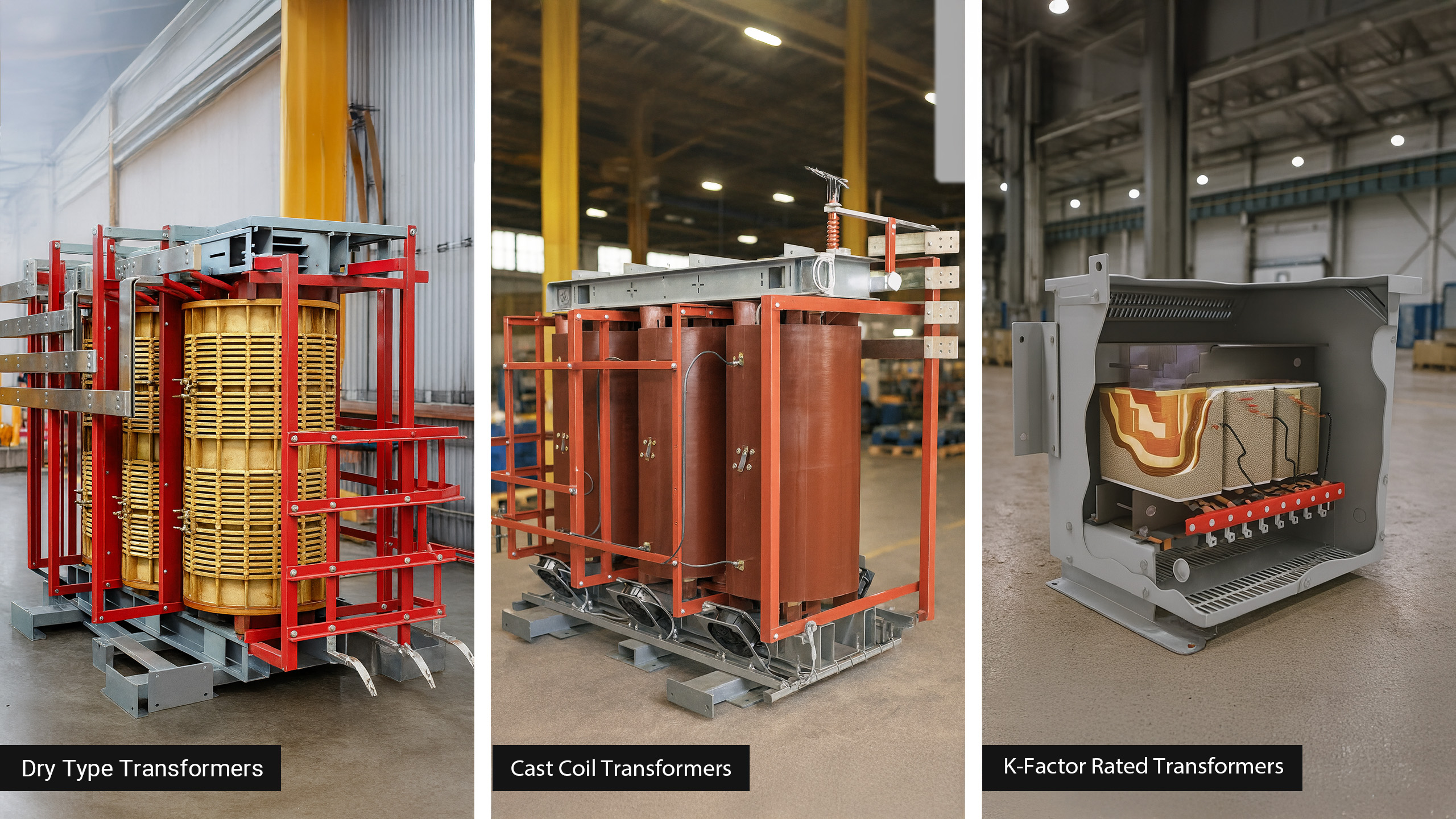Types of Transformers Explained – The Complete Guide
Transformers are indispensable in modern electrical systems, enabling the safe and efficient transmission of electrical energy. Their core function is to change voltage levels, either stepping voltage up for transmission or stepping it down for safe use. But what exactly are the different types of transformers, and how do they work?
In this comprehensive guide, we’ll explore the main transformer classifications, their functions, and applications across the power industry.
Primary Types of Transformers by Function
1. Step-Up Transformer
A step-up transformer increases voltage levels, making it ideal for long-distance power transmission. Higher voltage reduces energy loss, improving efficiency. You’ll typically find these transformers in power generation stations where electricity is prepared for transmission through high-voltage lines.
2. Step-Down Transformer
A step-down transformer reduces high transmission voltage to safe, usable levels. These are crucial in substations and at the end of transmission lines, ensuring power delivered to homes, offices, and factories is safe and efficient.
3. Isolation Transformer
An isolation transformer provides galvanic isolation between its primary and secondary windings, meaning there’s no direct electrical connection between circuits. This enhances safety and protects sensitive equipment — commonly used in medical facilities, laboratories, and industrial automation systems.
4. Power Transformer
Power transformers handle large electrical loads and operate at high voltage levels. They are essential in generation, transmission, and distribution networks, ensuring energy is transferred efficiently from one stage of the grid to another.
5. Generator Transformer
A generator transformer steps up voltage from the power plant’s generator to transmission-level voltages. Designed to handle high outputs, these transformers are key to efficient long-distance energy delivery.
6. Transmission Transformer
Used in substations, transmission transformers manage high-voltage electricity across long distances. They’re engineered to withstand heavy electrical and thermal stress while maintaining reliability and stability.
7. Distribution Transformer
Distribution transformers deliver the final voltage to consumers, stepping down transmission voltage to usable levels for residential, commercial, and industrial applications. They are the most common transformers in everyday electrical systems.
Classification of Transformers by Cooling Method
Efficient transformer cooling prevents overheating and ensures long-term performance.
1. Oil-Immersed Transformer
In oil-immersed transformers, the oil absorbs heat from the core and windings, dissipating it efficiently. These are ideal for outdoor or high-power applications, offering superior thermal performance.
2. Dry-Type Transformer
Dry-type transformers use air or inert gases for cooling instead of oil, making them safer for indoor environments such as hospitals, commercial buildings, and data centers where fire safety is a priority.
Special-Purpose Transformers
Beyond standard voltage transformation, several transformers are designed for specific industrial or technical applications.
1. Instrument Transformer
Instrument transformers, including current transformers (CTs) and potential transformers (PTs), are used for metering, protection, and monitoring. They provide accurate voltage and current measurements in high-voltage systems.
2. Autotransformer
An autotransformer uses a single winding for both the primary and secondary sides. Compact and efficient, they’re used where size, cost, and efficiency outweigh the need for complete electrical isolation.
3. K-Factor Rated Transformer
K-Factor rated transformers are designed to handle non-linear loads and harmonic distortion, commonly found in industrial systems with variable-speed drives or computing equipment.
4. Harmonic Mitigating Transformer
Harmonic mitigating transformers improve power quality by reducing harmonic distortion, protecting electrical equipment from overheating and inefficiencies.
5. General-Purpose Isolation Transformer
General-purpose isolation transformers are used across a variety of applications — from medical to laboratory equipment—general-purpose isolation transformers enhance safety and protect sensitive devices from electrical disturbances.
6. Industrial Control Transformer
Industrial control transformers supply power to control circuits in industrial equipment, providing stable voltage despite sudden load changes. Their primary role is to ensure reliable operation of control devices such as relays, solenoids, and contactors. You’ll typically find these transformers in manufacturing plants, automation systems, and process control panels where consistent performance and safety are critical.
7. Cast Coil Power Transformer
Cast coil power transformers use epoxy resin to encapsulate the windings, offering excellent protection against dust, moisture, and corrosive environments. This design enhances mechanical strength and fire resistance, making them ideal for indoor or harsh industrial settings such as chemical plants, mining operations, and offshore installations. Cast coil power transformers combine the durability of oil-immersed types with the safety of dry-type transformers.
Key Takeaways
- Transformers are essential for managing voltage across power generation, transmission, and distribution systems.
- Step-up and step-down transformers are the foundation of efficient power delivery.
- Power and distribution transformers serve large-scale electrical infrastructures.
- Cooling methods — oil-immersed and dry-type — affect transformer efficiency and application suitability.
- Special-purpose transformers like autotransformers and instrument transformers cater to unique industrial needs.
- They also play a pivotal role in renewable energy integration, power grid stability, and electrical safety across all sectors.
Final Thoughts
Understanding the different types of transformers and their specific functions is key to designing, maintaining, and optimizing electrical systems. Whether it’s for high-voltage transmission or precision applications in sensitive environments, each transformer type contributes to a safe, efficient, and reliable power network.
As a proud manufacturing partner of Arbutus West Agency Limited, we invite you to explore more insights and transformer solutions from Rex Power Magnetics.


